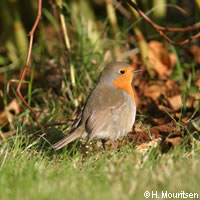European robins 'see' Earth's magnetic field
European robins use part of their visual centre for magnetic compass orientation during their migration, according to new research by scientists from Germany and New Zealand. Published in the journal Nature for the first time, the research proves that a brain region called 'cluster N' is responsible for the birds' magnetic sensitivity. The findings could help protect migratory birds and other animal species, and further our understanding of the effects of magnetic fields on organisms in general, including humans. The researchers of the University of Oldenburg in Germany and the University of Auckland in New Zealand identified cluster N as playing a key role in magnetic compass orientation by deactivating it in the birds through surgery. When testing the birds' orientation again, they found that magnetic field information could no longer be processed. Instead, the robins had to rely on the Sun or stars to navigate. 'These data show that cluster N is required for magnetic compass orientation in this species and indicate that it may be specifically involved in processing of magnetic compass information,' the study reads. A second hypothesis had assumed that magnetic compass orientation might depend on magnetoreceptors (iron mineral crystals) in the upper beak of the birds, with the information being passed on to the brain by the trigeminal nerve. Cutting the trigeminal connection of those magnetoreceptors to the brain, however, did not have an impact on the robins' magnetic compass orientation skills. 'Furthermore, the data strongly suggest that a vision-mediated mechanism underlies the magnetic compass in this migratory songbird,' the paper continues, 'and that the putative iron-mineral-based receptors in the upper beak connected to the brain by the trigeminal nerve are neither necessary nor sufficient for magnetic compass orientation in European robins.' Talking about a milestone in sensory biology, the researchers emphasise that their discovery could help protect migratory birds. A better understanding of their orientation mechanisms could make it possible to successfully relocate endangered populations to new breeding grounds, for instance, a feat that has often failed in the past. At the same time, the researchers believe their findings could ultimately result in a more precise understanding of the impact of magnetic fields on molecules, proteins and cells in other organisms, including the exposure of humans to electromagnetic radiation from mobile phones or imaging techniques in a diagnostic context. The European robin is found across Europe, its distribution area reaching as far east as western Siberia and as far south as northern Africa. In some regions, robins are resident and will stay in one place during the winter months. Others will migrate to southern Europe to avoid colder temperatures.
Countries
Germany, New Zealand



